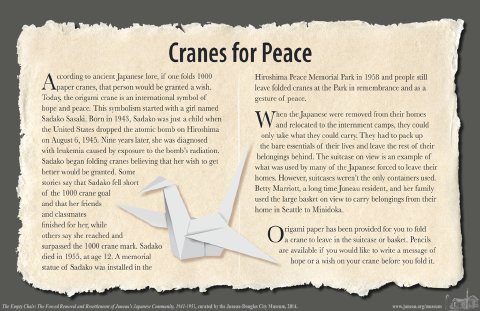|
Description
|
| Cranes, Suitcase and Basket According to ancient Japanese lore, if one folds 1000 paper cranes, that person would be granted a wish. Today, the origami crane is an international symbol of hope and peace. This symbolism started with a girl named Sadako Sasaki. Born in 1943, Sadako was just a child when the United States dropped the atomic bomb on Hiroshima on August 6, 1945. Nine years later, she was diagnosed with leukemia caused by exposure to the bomb's radiation. Sadako began folding cranes believing that her wish to get better would be granted. Some stories say that Sadako fell short of the 1000 crane goal and that her friends and classmates finished for her, while others say she reached and surpassed the 1000 crane mark. Sadako died in 1955, at age 12. A memorial statue of Sadako was installed in the Hiroshima Peace Memorial Park in 1958 and people still leave folded cranes at the Park in remembrance and as a gesture of peace. When the Japanese were removed from their homes and relocated to the internment camps, they could only take what they could carry. They had to pack up the bare essentials of their lives and leave the rest of their belongings behind. The suitcase on view is an example of what was used by many of the Japanese forced to leave their homes. However, suitcases weren't the only containers used. Betty Marriott, a long time Juneau resident, and her family used the large basket on view to carry belongings from their home in Seattle to Minidoka. |
History of Cranes Panel
-The Empty Chair: The Forced Removal and Relocation of Juneau's Japanese, 1941-1951
-Permission to use this image may be obtained by contacting museum staff.

All images are the property of the Juneau-Douglas City Museum. No image may be copied, downloaded or reproduced without the express permission of the Juneau-Douglas City Museum.

All images are the property of the Juneau-Douglas City Museum. No image may be copied, downloaded or reproduced without the express permission of the Juneau-Douglas City Museum.